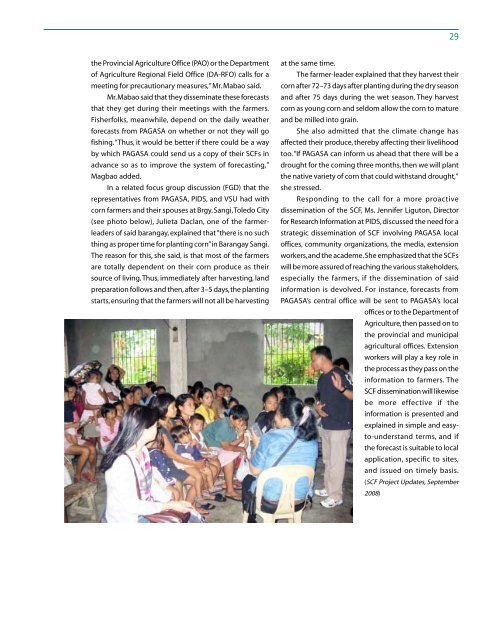Read More - Philippine Institute for Development Studies
Read More - Philippine Institute for Development Studies
Read More - Philippine Institute for Development Studies
Create successful ePaper yourself
Turn your PDF publications into a flip-book with our unique Google optimized e-Paper software.
29<br />
the Provincial Agriculture Office (PAO) or the Department<br />
of Agriculture Regional Field Office (DA-RFO) calls <strong>for</strong> a<br />
meeting <strong>for</strong> precautionary measures,” Mr. Mabao said.<br />
Mr. Mabao said that they disseminate these <strong>for</strong>ecasts<br />
that they get during their meetings with the farmers.<br />
Fisherfolks, meanwhile, depend on the daily weather<br />
<strong>for</strong>ecasts from PAGASA on whether or not they will go<br />
fishing. “Thus, it would be better if there could be a way<br />
by which PAGASA could send us a copy of their SCFs in<br />
advance so as to improve the system of <strong>for</strong>ecasting,”<br />
Magbao added.<br />
In a related focus group discussion (FGD) that the<br />
representatives from PAGASA, PIDS, and VSU had with<br />
corn farmers and their spouses at Brgy. Sangi, Toledo City<br />
(see photo below), Julieta Daclan, one of the farmerleaders<br />
of said barangay, explained that “there is no such<br />
thing as proper time <strong>for</strong> planting corn” in Barangay Sangi.<br />
The reason <strong>for</strong> this, she said, is that most of the farmers<br />
are totally dependent on their corn produce as their<br />
source of living. Thus, immediately after harvesting, land<br />
preparation follows and then, after 3–5 days, the planting<br />
starts, ensuring that the farmers will not all be harvesting<br />
at the same time.<br />
The farmer-leader explained that they harvest their<br />
corn after 72–73 days after planting during the dry season<br />
and after 75 days during the wet season. They harvest<br />
corn as young corn and seldom allow the corn to mature<br />
and be milled into grain.<br />
She also admitted that the climate change has<br />
affected their produce, thereby affecting their livelihood<br />
too. “If PAGASA can in<strong>for</strong>m us ahead that there will be a<br />
drought <strong>for</strong> the coming three months, then we will plant<br />
the native variety of corn that could withstand drought,”<br />
she stressed.<br />
Responding to the call <strong>for</strong> a more proactive<br />
dissemination of the SCF, Ms. Jennifer Liguton, Director<br />
<strong>for</strong> Research In<strong>for</strong>mation at PIDS, discussed the need <strong>for</strong> a<br />
strategic dissemination of SCF involving PAGASA local<br />
offices, community organizations, the media, extension<br />
workers, and the academe. She emphasized that the SCFs<br />
will be more assured of reaching the various stakeholders,<br />
especially the farmers, if the dissemination of said<br />
in<strong>for</strong>mation is devolved. For instance, <strong>for</strong>ecasts from<br />
PAGASA’s central office will be sent to PAGASA’s local<br />
offices or to the Department of<br />
Agriculture, then passed on to<br />
the provincial and municipal<br />
agricultural offices. Extension<br />
workers will play a key role in<br />
the process as they pass on the<br />
in<strong>for</strong>mation to farmers. The<br />
SCF dissemination will likewise<br />
be more effective if the<br />
in<strong>for</strong>mation is presented and<br />
explained in simple and easyto-understand<br />
terms, and if<br />
the <strong>for</strong>ecast is suitable to local<br />
application, specific to sites,<br />
and issued on timely basis.<br />
(SCF Project Updates, September<br />
2008)










